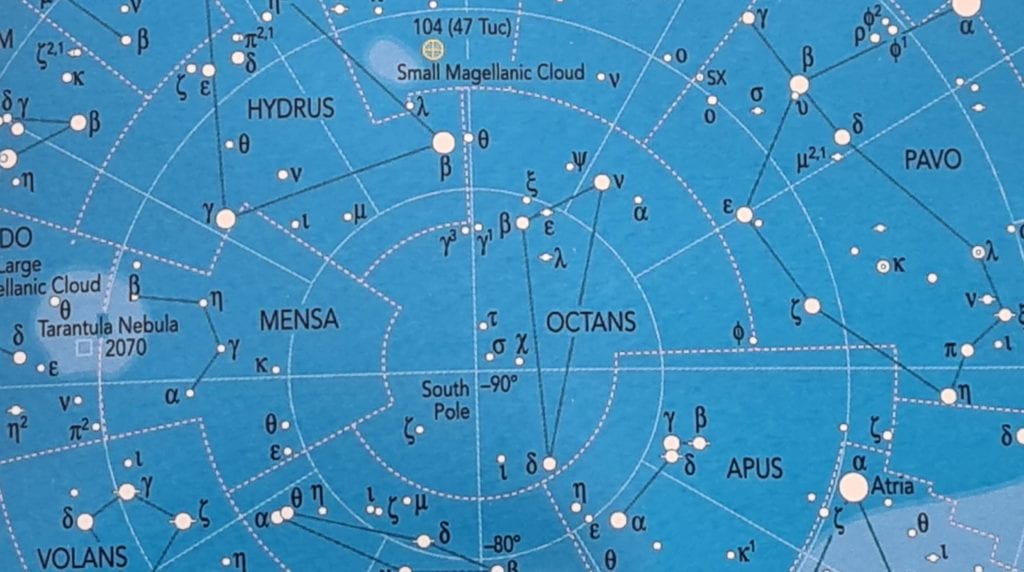
Octans constellation is faint in appearance and located in the southern sky. It represents the octant, a navigational instrument. The South Celestial Pole is located in this constellation.
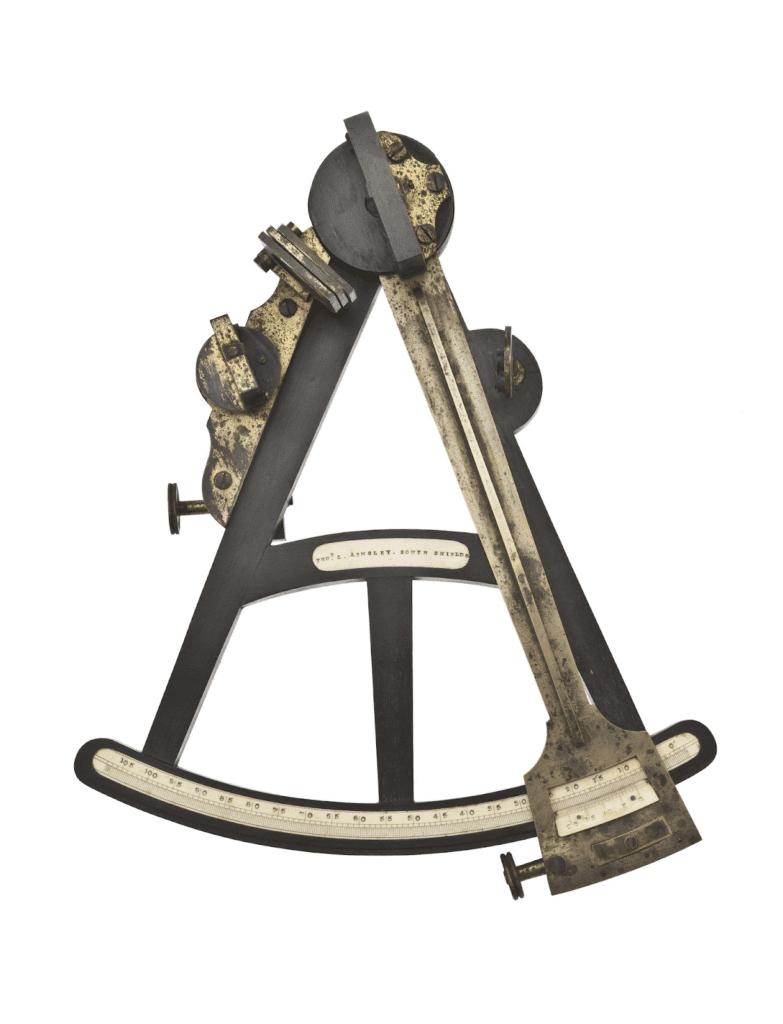
Octans is not one of the classical Greek constellations introduced by Ptolemy in his 2nd-century Almagest. It was not visible to the Greeks and other ancient astronomers because it is located in the far south. And because it is rather a newcomer, people in the past did not associate any mythological stories with it. It was invented in 1752 by the French astronomer Nicolas Louis de Lacaille.
The International Astronomical Union (IAU) recognizes it as one of the 88 modern constellations of today. It occupies an area of 291 square degrees, making it the 50th largest constellation. That area fills about 0.71% of our night sky. The abbreviation used for it is Oct and the genitive, the name we use in its stars, is Octantis.
This constellation does not contain any star brighter than the third magnitude. The star assigned with the Alpha designation is not the brightest in Octans. It belongs to the 3.37-magnitude Nu Octantis. The second brightest star is Beta Octantis. It shines with an apparent magnitude of 4.13.
The Southern Pole
Since the South Pole is in the constellation, it also contains the southern pole star. This title is now given to the star Sigma Octantis. Another name for the southern pole star is Polaris Australis, the official name given to it and approved by the IAU. It lies about 1 degree from the true South Celestial Pole.
Interestingly, another pole star is found in this constellation. The second-largest planet in our Solar System, Saturn, has its southern pole star in Octans. It is the orange-hued star Delta Octantis.
The celestial octant has no Messier objects. One meteor shower is associated with the constellation. However, at least three of its stars have exoplanets. Notable deep-sky objects within its boundary include the open cluster Collinder 411. Some of the barred spiral galaxies are NGC 7098, NGC 7095, and NGC 2573.
What’s In A Name?
Nicolas Louis de Lacaille had a book that was published in 1763 after his death. The title of this southern sky catalogue is Coelum Australe Stelliferum. The name he used for Octans in that catalogue was l’Octans de Reflexion. The name means “the reflecting octant” in English.
It was called differently in Europe. They called it Octans Hadleianus after John Hadley. He was an English mathematician who invented the octant around 1763. Another inventor, Thomas Godfrey, was also credited to have invented the instrument around the same time.

Quick Check: How Octans Came to Be
Nicolas Louis de Lacaille went to the Cape of Good Hope (now South Africa) to study the southern sky. He stayed there from 1750 to 1754 and catalogued about 10,000 southern stars. Before that, much of the southern stars and constellations were uncharted because they were not visible to European astronomers.
He created 14 new constellations during his stay. Octans is one of them.
The constellation of Octans is in the Lacaille family of constellations, after its creator. Other constellations in the family are:
- Antlia
- Caelum
- Circinus
- Fornax
- Horologium
- Mensa
- Microscopium
- Norma
- Pictor
- Reticulum
- Sculptor
- Telescopium
Thirteen of Lacaille’s constellations were based on the instruments that revolutionized the Age of Enlightenment. The other one, Mensa, is the only constellation that was from a different inspiration. It was based on Table Mountain, a famous flat-topped mountain in Cape Town, South Africa.
They became their own family of constellations, except one. The constellation of Pyxis belongs to the Heavenly Waters family.
The octant is the predecessor of another navigational tool called a sextant. Its name is based on its arc measuring one-sixth of a circle or 60 degrees. This instrument became the basis for another southern constellation known as Sextans.
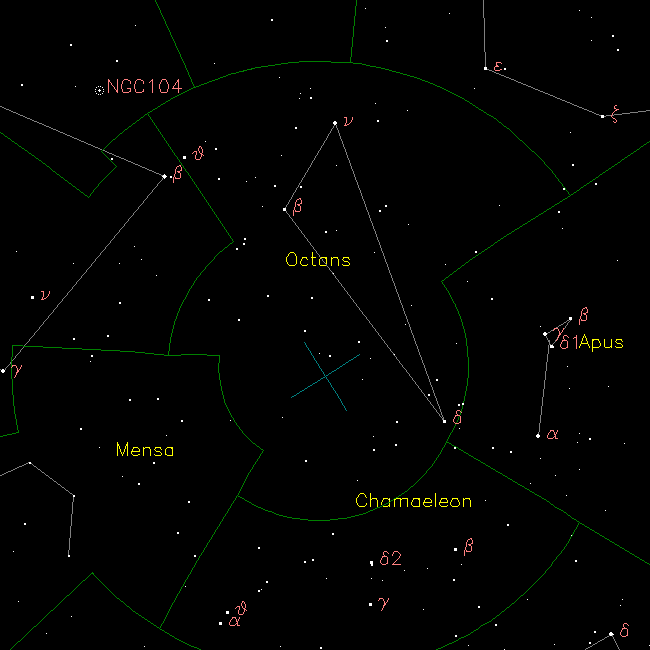
What Does Octans Look Like?
The boundaries of Octans circle around the south celestial pole. Its constellation outline is marked by three of the brighter stars in its overall faint constellation. The stars Nu Octantis, Beta Octantis, and Delta Octantis, are connected in a triangular form.
Other versions of the constellation outline demonstrate a fourth line sticking out from Beta Octantis. It extends to the star Theta Octantis. It just goes to show that we can be creative in interpreting the stars that make up our sky’s constellations!
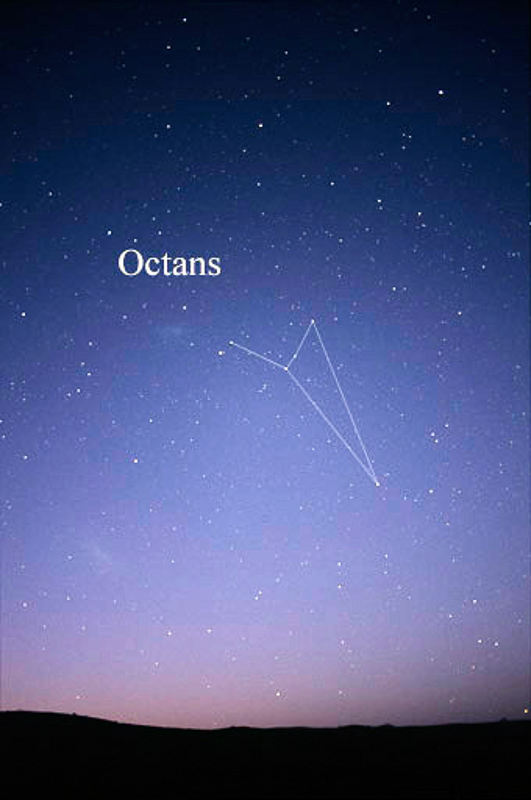
Where To See the Octans Constellation
Octans is in the fourth quadrant of the southern hemisphere (SQ4). Its location in the celestial sphere is at about 22h right ascension and −90° declination. The negative sign indicates that it is south in declination.
Remember that these celestial sphere coordinates are just like the Earth’s latitude and longitude. Right ascension (RA) is the equivalent of longitude. Meanwhile, declination (DEC) is like the latitude and is also expressed in degrees.
Going back to the constellation of Octans, it is visible between the latitudes +0° and −90°.
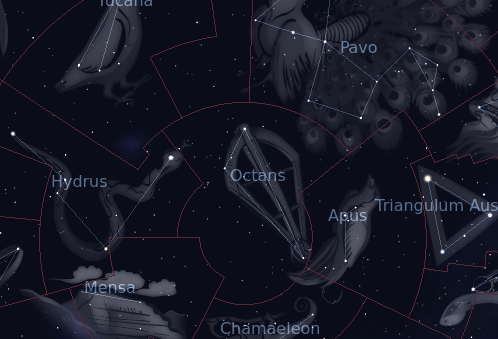
Octans and Its Neighbors
Octans is surrounded by other constellations in the far south. And because of their location, one common thing about them is that they are relatively new. They were added many years later after the classical Greek constellations were established.
The nearby constellations are Tucana (the Toucan), Indus (the Indian), Pavo (the Peacock), Apus (the Bird-of-Paradise), Chamaeleon (the Chameleon), Mensa (the Table Mountain), and Hydrus (the Male Water Snake). We can use them to spot the outline of the sky’s octant near the south celestial pole.
Finding the Southern Celestial Pole
The northern star, Polaris, is useful for mariners during navigation. We might think that the case is the same with the pole star of the south. With its position near the south pole, it can also aid sailors at sea. However, the southern pole star, Sigma Octantis, is relatively faint. It is less bright than the North Star by about 25 times. It does not serve as much use as the northern star for navigation.
The most important constellation in finding due south is the Southern Cross in the Crux constellation. We can use two of its stars, Gamma Crucis and Alpha Crucis, to find it. If we try to connect them, the line will point us to the South Pole.
When To See the Octans Constellation
Octans is a southern circumpolar constellation because of its far south declination. The South Celestial Pole is located within its boundaries. All constellations rotate around this pole, and the same is also true with the North Celestial Pole. Circumpolar constellations are visible all the time because they do not dip or go below the horizon.
In the areas where Octans is visible, the best time to see it is in the month of October at about 9 pm.
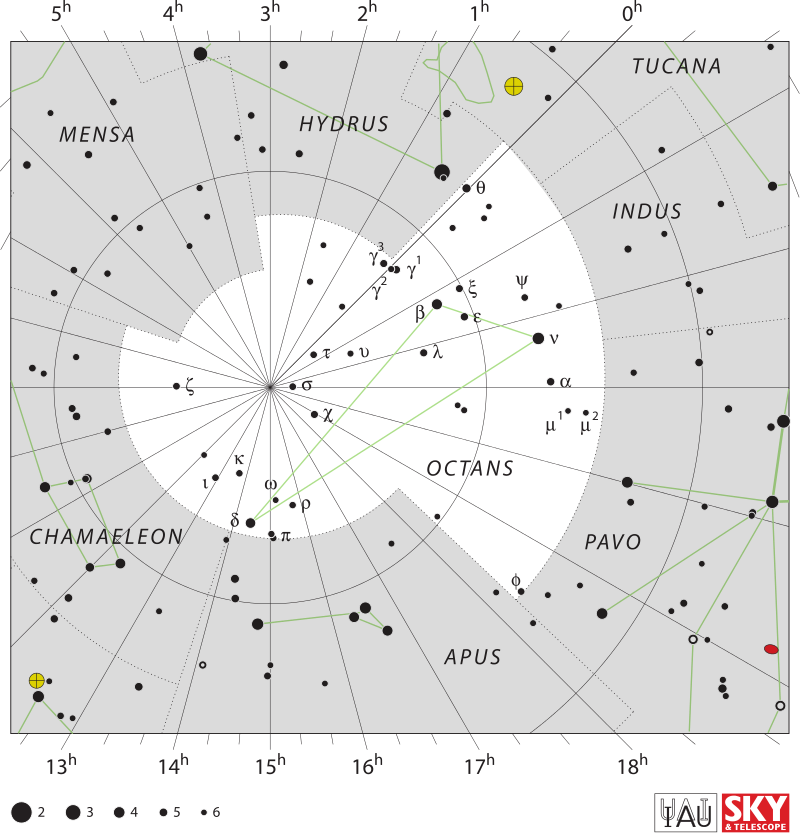
Octans and Its Stars
Nicolas Louis de Lacaille moved some stars from the nearby constellation of Hydrus when he created Octans. Since then, more and more stars were discovered. There are about 794 stars scanned by the Hipparcos satellite in this constellation. About 35 of them are visible to the naked eye under a clear sky. It has Mira variables, given the variable star designations R Octantis and T Octantis.
Some of the stars in Octans host extrasolar planets. Below are its most notable stars, some of them share the same Bayer designation.
Alpha Octantis (α Octantis)
Alpha Octantis is a double-lined spectroscopic binary. It is not the brightest star in the constellation even though it was given the alpha designation. Its overall apparent magnitude is 5.13.
The components of this star system are giant stars in the F class. Their stellar classifications are F4III and F5III. They are Beta Lyrae variables, a pair of stars that orbit each other. Its magnitude changes because one of the two stars periodically passes in front of the other, blocking it. When that happens, its magnitude drops by 0.04. The system is 148 light-years from the Sun.
Beta Octantis (β Octantis)
Beta Octantis is an A-type star with an apparent magnitude of 4.13. It is a suspected binary. The visible component is an evolving star, having the traits of a main-sequence star and a subgiant. Its stellar classification is A9IV-V. It is 2.27 times as massive as the Sun. It radiates with the luminosity of 42 Suns. This star is 149 light-years from the Sun.
Gamma Octantis (γ Octantis)
Gamma Octantis is a designation shared by three stars. They are γ1 Octantis, γ2 Octantis, and γ3 Octantis. They all share a yellow hue.
The star Gamma1 Octantis has an apparent magnitude of 5.10. It is 1.81 times as massive as the Sun and about 69 times as luminous. It generates energy through helium fusion that is why it is classified as a red clump star. Gamma Octantis belongs to the stellar class G7 III. This yellow star is approximately 265 light-years distant.
Delta Octantis (δ Octantis)
Delta Octantis is an orange giant with an apparent magnitude of 4.31. It has the stellar classification of K2III. Its radius is about 25 times that of the Sun’s. It is nearly similar to the Sun in terms of mass and age.
This star is the southern pole star of another planet in our Solar System, the ringed-planet Saturn.
Epsilon Octantis (ε Octantis)
Epsilon Octantis is an M-type star with an apparent magnitude of 5.09. But since it is a semiregular variable, its magnitude can vary from 4.58 to 5.3. It has a period of 55 days.
This cool red giant is in the stellar class M5III. It is as massive as our Sun by about 1.34 times. The luminosity of this star is about 1,819 times that of the Sun’s. It is located 291 light-years from us.
Theta Octantis (θ Octantis)
Theta Octantis is an orange-hued star. It is an aging giant in the spectral class K3III. Its apparent magnitude is 4.78 so it is visible to the naked eye. This star is located near the border of the neighboring constellation of Hydrus.
The radius of Theta Octantis equates to nearly 16 times the solar radius. It is 1.20 times as massive as the Sun and 79 times as luminous. It lies roughly 217 light-years from the Sun.
Kappa Octantis (κ Octantis)
Kappa Octantis is a star that has a bluish hue. Its spectral type is A2m. We can see it faintly with the naked eye as its apparent magnitude is 5.56. Its estimated distance is 273 light-years.
Lambda Octantis (λ Octantis)
Lambda Octantis is a binary star. Its primary component has a yellow hue. Its stellar classification is G8-K0III. The age of this giant star is about 200 million years, much younger than our Sun. It radiates with the luminosity of 102 Suns. The secondary component is an Am star or a metallic-line star.
The overall apparent magnitude of this system is 5.27. It is approximately 409 light-years from us.
Mu Octantis (Mu Octantis)
Mu Octantis is a designation shared by the stars μ1 Octantis and μ2 Octantis. They are separated by 50 arcminutes.
Mu2 Octantis is a star system with two components. Both of them are G-type stars in the main sequence. The primary is also designated HD 196067 in the Henry Draper Catalogue. An exoplanet was discovered around it. The other component is HD 196068. These stars are separated by about 17 arcseconds. They are also gravitationally bound with each other. Their estimated distance is 130 light-years.
Nu Octantis (ν Octantis)
Nu Octantis is a binary star system. Its apparent magnitude is 3.73, making it the brightest star in the constellation of Octans. The spectroscopic binary has a period of about 2.9 years.
The stellar classification of the primary is K1III. It is an orange giant that has already expanded. The other component may be a white dwarf or a red dwarf. The pair is approximately 69.1 light-years from the Sun. This star system has an unconfirmed exoplanet that is Jupiter-like in size.
Xi Octantis (ξ Octantis)
Xi Octantis is a B-type star with a stellar classification of B6IV. The apparent magnitude of this blue subgiant is 5.32. It is located roughly 492.69 light-years from Earth.
Omicron Octantis (ο Octantis)
Omicron Octantis has the stellar classification B9.5IV. This blue-hued star has an apparent magnitude of 7.22, so it is not visible to the naked eye. According to the 2007 Hipparcos data, it is 1792 light-years away.
Rho Octantis (ρ Octantis)
Rho Octantis is an A-type star in the main sequence. It has a blue-white color as indicated in its stellar classification A2V. The radius of this star is about 2.27 times greater than that of the Sun’s. It radiates with the luminosity of 21.91 Suns. It is 215.72 light-years distant.
Polaris Australis (σ Octantis)
Polaris Australis is the official name given to the current pole star of the south. In fact, it is the southernmost star that was assigned a name. It is called Sigma Octantis in the Bayer designation. It is a Delta Scuti variable, which means that its apparent brightness changes. The average magnitude of this giant star is 5.47. It belongs to the spectral class F0 III.
Though it is the closest star in the true South Celestial Pole, it does not serve many purposes because of its faintness. For that reason, the constellation of Crux is used to locate the South Celestial Pole. The southern polestar is 294 light-years from us.
Tau Octantis (τ Octantis)
Tau Octantis is a giant star with the stellar classification K2III. Its designation in the Henry Draper catalogue is HD219765. With the apparent magnitude of 5.50, we can see it faintly with the naked eye under a clear sky. It radiates with the luminosity of about 229 Suns. This orange star is 486.09 light-years from our planet, Earth.
BQ Octantis
BQ Octantis is an S-type star. An S-type star is a cool giant that has more or less the same quantities of oxygen and carbon in the atmosphere. It is actually closer to the South Celestial Pole than Polaris Australis. However, its apparent magnitude is only 6.82, too faint to see with the naked eye. It is a variable star, it has an amplitude of about 0.05 magnitudes.
The stellar classification of BQ Octantis is M3III or M4III. This red giant is a cool star that is on the asymptotic giant branch. It is about 1900 light-years from the Sun.
R Octantis
R Octantis is another variable star in Octans. It is classified as a Mira variable, a pulsating star with a very red color. Its apparent magnitude ranges between 6.4 and 13.2. It is more luminous than the Sun by about 9,304 times. Its estimated distance from us is 1,600 light-years.
HD 142022
HD 142022 is a multiple-star system. Its primary component is a yellow star in the stellar class G9IV-V. The age of this star is 7.6 billion years already. It is nearly as massive as the Sun. Its radius is about the same, 1.028 times the solar radius. Its apparent magnitude is 7.70.
The other component is much fainter, 11.19 in magnitude. This red dwarf has a stellar classification of M1V.
A planet was discovered around the primary star. This system lies 112 light-years away from us.
HD 212301
HD 212301is 7.76 in magnitude, making it invisible to the naked eye. It is a binary star system. Another designation used for this star is HIP 110852.
The primary component (or component A) has a stellar classification of F8V. This main-sequence star is more massive than the Sun by about 1.20 times. It is more luminous by about 1.9 times. An exoplanet was discovered around it. The other component is separated 4.4″ from the primary. It is a red dwarf, the coolest star in the main sequence. This system is located about 177 light-years away.
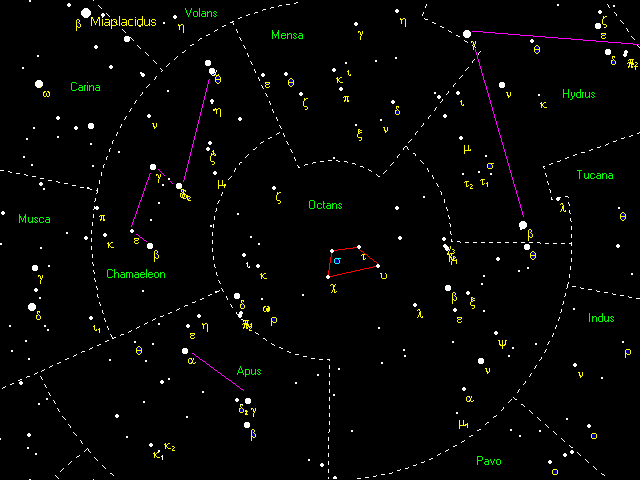
Asterism Related to Octans Constellation
A trapezoidal asterism is formed in the constellation of Octans. It is useful in locating the relatively dim pole star of the south. The stars in this asterism are Chi Octantis, Tau Octantis, Upsilon Octantis, and the fourth one, completing it, is the pole star Sigma Octantis.
By forming this distinct trapezoid shape in the southern sky, we are a step closer to the location of the South Celestial Pole.
Planets in the Octant’s Constellation
Four stars in the constellation of Octans were discovered to host planets. And as we explore the sky more and more, surely that number will rise!
HD 142022A b
HD 142022A b is a gas giant, just like the largest planet in our Solar System, Jupiter. It is 2.93 AU from its yellow star. It has an orbital period of 5.3 years. This exoplanet is as massive as 4.44 Jupiters.
HD 212301 b
HD 212301b is another gas giant that orbits a star in the Octans constellation. Its mass equates to 0.51 Jupiters. Its orbital period is 2.2 days. The discovery of this gas planet was declared in 2005.
HD 196067 b
HD 19606 b is a giant planet. It has a mass of 6.9 Jupiters. It is 5.02 AU from the star HD 19606. This giant planet has an orbital period of 10 years. This gas giant was discovered in 2012 using the radial velocity method.
HD 221420 b
HD 221420 b is an exoplanet discovered in 2019. This gas giant is very massive, which equates to 9.7 Jupiters. It is 18.5 AU from the yellow-hued star in its star system. Its orbital period is a long one, which is about 61.6 years.
Deep-sky Objects in Octans Constellation
Not that many bright deep-sky objects are located in the celestial octant. One of the most notable is the open cluster Collinder 411. It is considered the southernmost object in the Collinder catalogue.
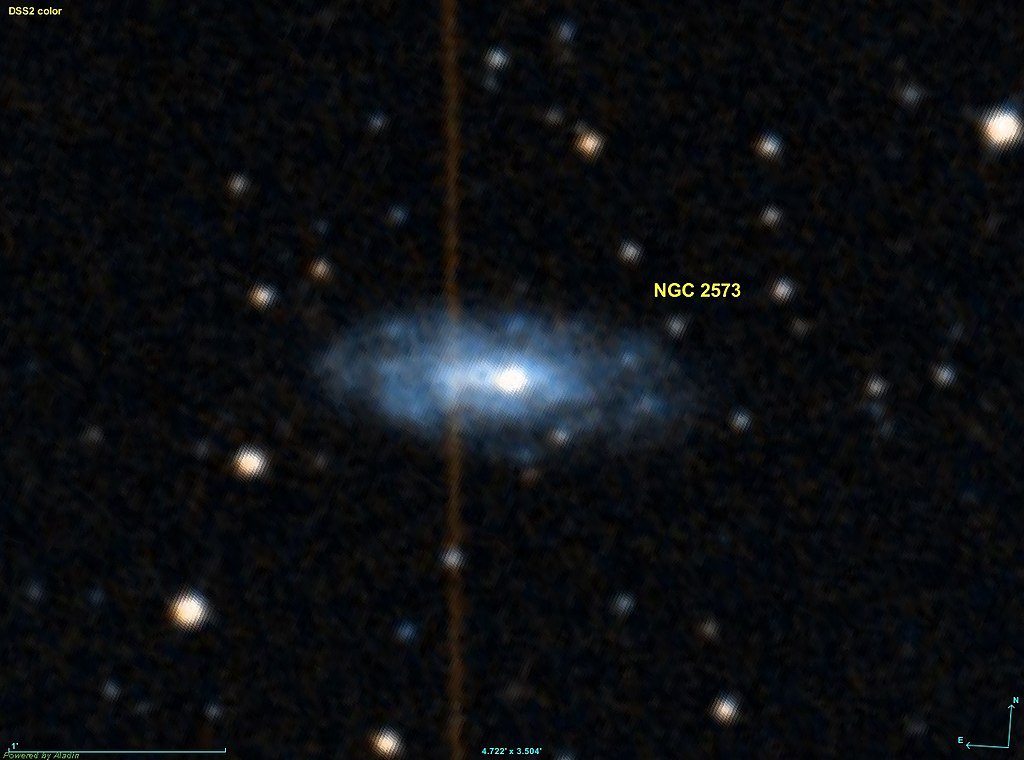
NGC 2573
NGC 2573 is a barred spiral galaxy. It was discovered by English astronomer John Herschel in 1837. This celestial object is actually the South Celestial Pole’s closest NGC object. Because of that, it is also called Polarissima Australis.
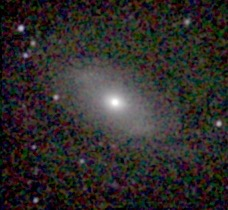
NGC 7098
NGC 7098 is another barred galaxy in Octans. It is 152,400 light-years across. It has a prominent bar at the center. Four spiral arms are around it. No stars are born in the center of this galaxy because of the absence of dust lanes. It is 95 million light-years from us.
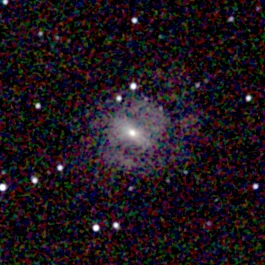
NGC 7095
NGC 7095 is a galaxy that was discovered in 1837 by John Herschel. We cannot see it with the naked eye because its apparent magnitude is 12.23. This barred spiral galaxy is 115 million light-years away from Earth.